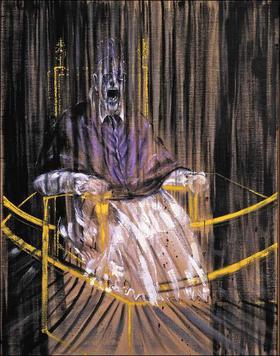Facts About Study after Velázquez's Portrait of Pope Innocent X
"Study after Velázquez's Portrait of Pope Innocent X" is a 1953 painting by Francis Bacon that reimagines Diego Velázquez's renowned portrait in a hauntingly distorted manner. Throughout the 1950s and early 1960s, Bacon produced approximately 50 versions of this piece, each offering a modern twist on the classic. Bacon harbored a profound admiration for Old Masters such as Titian, Rembrandt, Velázquez, and Goya, yet he seldom painted directly from life. Instead, he drew inspiration from a variety of visual sources.
In this painting, Bacon depicts a screaming Pope enveloped in dark, rich colors and heavy drapery, conjuring a nightmarish scene. Around 1953, Bacon's color palette shifted towards darker, more nocturnal tones, possibly reflecting his personal turmoil, including the end of a tumultuous relationship. The Pope is often portrayed within a cage-like structure, symbolizing feelings of isolation and entrapment.
Bacon incorporated elements such as frames and curtains, inspired by artists like Giacometti and Moore, to convey a sense of imprisonment. The vertical folds in his works, reminiscent of curtains, accentuate the figure's solitude. Critics have offered various interpretations of Bacon's repeated reinterpretations of Velázquez's painting, with some viewing them as symbolic execution scenes or representations of a father figure's demise.
Bacon's fascination with Velázquez's work was driven by his interest in exploring colors and expressing his inner struggles, rather than any particular animosity towards popes. As a self-identified Nietzschean and atheist, Bacon rejected straightforward symbolic interpretations of his paintings. Ultimately, "Study after Velázquez's Portrait of Pope Innocent X" stands as a remarkable masterpiece within Bacon's oeuvre, showcasing his distinctive style and complex themes.

 Canada
Canada